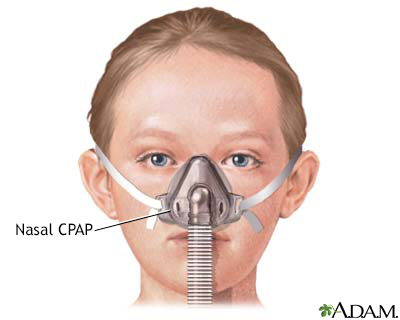Pregnancy SmartSiteTM
Continuous positive airway pressure; CPAP; Bilevel positive airway pressure; BiPAP; Autotitrating positive airway pressure; APAP; nCPAP; Non-invasive positive pressure ventilation; NIPPV; Non-invasive ventilation; NIV; OSA - CPAP; Obstructive sleep apnea - CPAP DefinitionPositive airway pressure (PAP) treatment uses a machine to pump air under pressure into the airway of the lungs. This helps keep the windpipe open during sleep. The forced air delivered by CPAP (continuous positive airway pressure) prevents episodes of airway collapse that block the breathing in people with obstructive sleep apnea and other breathing problems. InformationWHO SHOULD USE PAP PAP can successfully treat most people with obstructive sleep apnea. It is safe and works well for people of all ages, including children. If you only have mild sleep apnea and do not feel very sleepy during the day, you may not need it. After using PAP regularly, you may notice:
Your health care provider will prescribe the type of PAP machine that targets your problem:
BiPAP is useful for children and adults who have:
PAP or BiPAP may also be used by people who have: HOW PAP WORKS When using a PAP setup:
You may start to use PAP while you are in a sleep center for the night. Some newer machines (self-adjusting or auto-PAP), may be set up for you and then just given to you to sleep with at home, without the need for a test to adjust the pressures.
If your symptoms don't improve after you're on PAP treatment, the settings on the machine may need to be changed. Your provider may teach you how to adjust the settings at home. Or, you may need to go to the sleep center to have it adjusted. GETTING USED TO THE MACHINE It can take time to get used to using the PAP setup. The first few nights are often the hardest and you may not sleep well. If you are having problems, you may be tempted not to use the machine for the whole night. But you will get used to it more quickly if you use the machine for the entire night. When using the setup for the first time, you may have:
Many of these problems can be helped or prevented.
Your provider can lower the pressure on the machine and then increase it again at a slow pace. Some new machines can automatically adjust to the right pressure. ReferencesFreedman N, Johnson K. Positive airway pressure treatment for obstructive sleep apnea. In: Kryger M, Roth T, Goldstein CA, Dement WC, eds. Principles and Practice of Sleep Medicine. 7th ed. Philadelphia, PA: Elsevier; 2022:chap 132. Kimoff RJ, Kaminska M, Pamidi S. Obstructive sleep apnea. In: Broaddus VC, King TE, Ernst JD, et al, eds. Murray & Nadel's Textbook of Respiratory Medicine. 7th ed. Philadelphia, PA: Elsevier; 2022:chap 120. Patil SP, Ayappa IA, Caples SM, Kimoff RJ, Patel SR, Harrod CG. Treatment of adult obstructive sleep apnea with positive airway pressure: an American Academy of Sleep Medicine clinical practice guideline. J Clin Sleep Med. 2019;15(2):335-343. PMID: 30736887 pubmed.ncbi.nlm.nih.gov/30736887/. Shangold L, Jacobowitz O. CPAP, APAP, and BiPAP. In: Friedman M, Jacobowitz O, eds. Sleep Apnea and Snoring. 2nd ed. Philadelphia, PA: Elsevier; 2020:chap 8. | ||
| ||
Review Date: 4/10/2025 Reviewed By: Allen J. Blaivas, DO, Division of Pulmonary, Critical Care, and Sleep Medicine, VA New Jersey Health Care System, Clinical Assistant Professor, Rutgers New Jersey Medical School, East Orange, NJ. Review provided by VeriMed Healthcare Network. Also reviewed by David C. Dugdale, MD, Medical Director, Brenda Conaway, Editorial Director , and the A.D.A.M. Editorial team. View References The information provided herein should not be used during any medical emergency or for the diagnosis or treatment of any medical condition. A licensed medical professional should be consulted for diagnosis and treatment of any and all medical conditions. Links to other sites are provided for information only -- they do not constitute endorsements of those other sites. No warranty of any kind, either expressed or implied, is made as to the accuracy, reliability, timeliness, or correctness of any translations made by a third-party service of the information provided herein into any other language. © 1997- A.D.A.M., a business unit of Ebix, Inc. Any duplication or distribution of the information contained herein is strictly prohibited. | ||


 Nasal CPAP
Nasal CPAP
